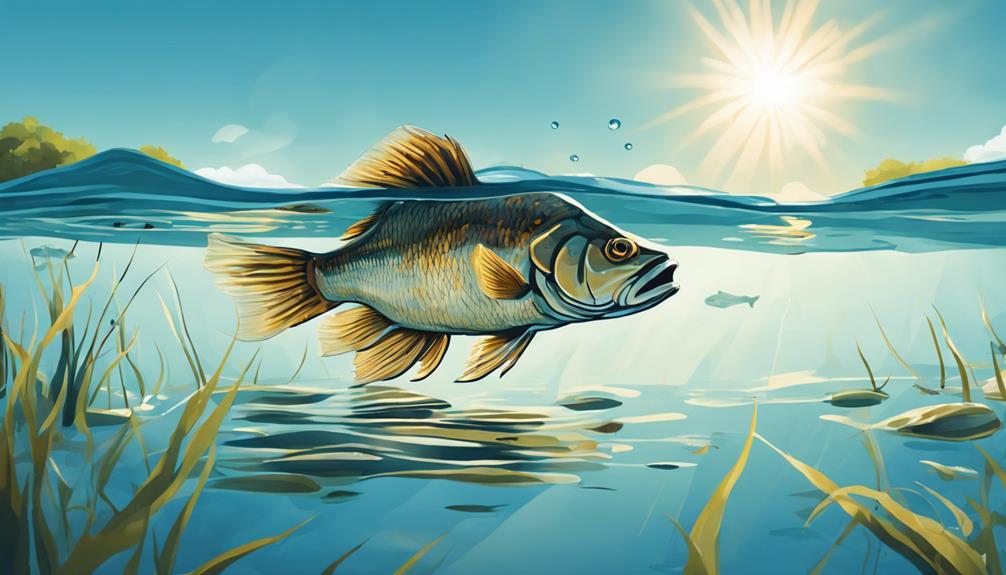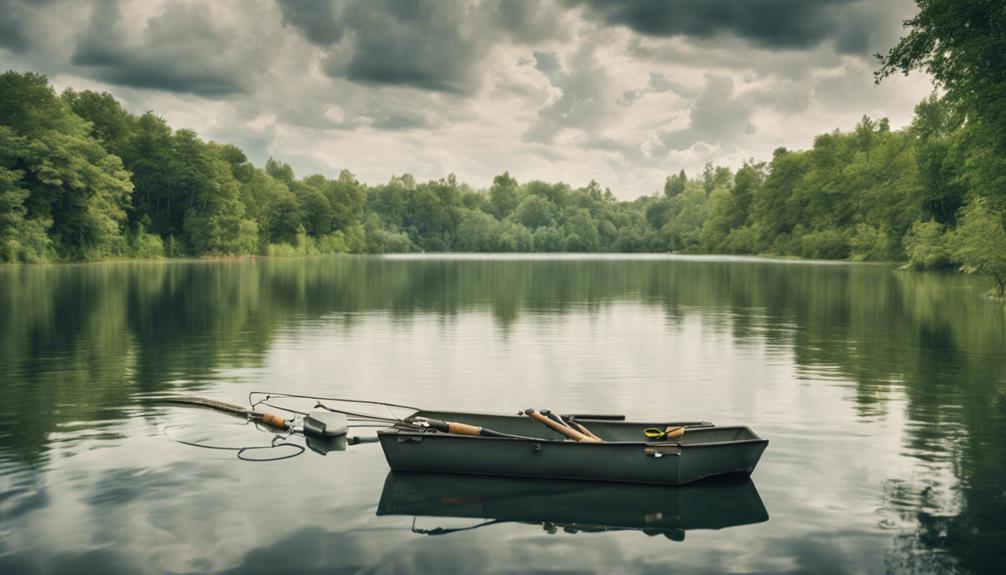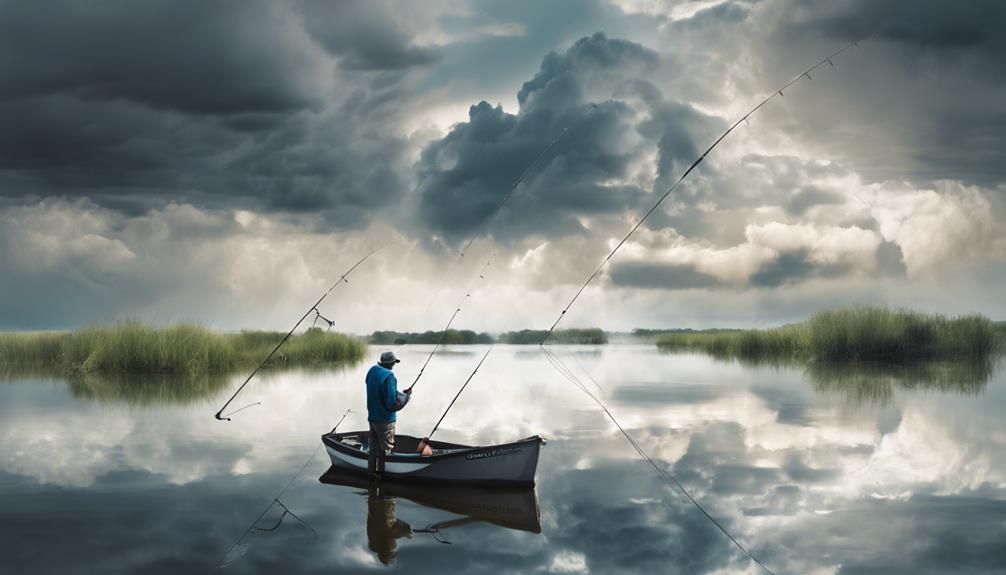Weather influences fish behavior through barometric pressure, water temperature, wind patterns, cloud cover, rainfall, solar radiation, moon phases, and seasonal changes. Changes in these factors impact fish movement, feeding habits, and overall behavior in aquatic environments. For example, high pressure can make fish lethargic, while low pressure increases their activity. Understanding these weather elements is crucial for anglers to adapt their fishing techniques for optimal success. Each weather component plays a vital role in shaping how fish behave in their habitats, making it essential for anglers to consider weather patterns for a successful fishing trip.
Barometric Pressure Impact on Fish
Barometric pressure directly influences the behavior of fish in a measurable and significant manner. Pressure changes in the atmosphere can have a profound impact on fish, particularly in relation to their feeding habits. When barometric swings occur, fish movement and behavior patterns are notably altered.
During periods of high barometric pressure, fish tend to be more lethargic and less active in their feeding habits. The increased pressure pushes down on the water, causing fish to feel more pressure in their swim bladders. This discomfort can lead to a decrease in their willingness to feed, as they may struggle to regulate their buoyancy effectively.
Conversely, when the barometric pressure drops, fish become more active and display heightened feeding behavior. The decrease in pressure allows fish to move more freely in the water, leading to increased foraging activities. Anglers often capitalize on these periods of low pressure to maximize their chances of a successful catch.
Understanding how barometric pressure affects fish behavior is crucial for anglers looking to improve their fishing success. By monitoring pressure changes and adapting their fishing techniques accordingly, anglers can optimize their opportunities to reel in the big catch.
Water Temperature Effects on Fishing
Water temperature plays a crucial role in influencing fish behavior and can significantly impact fishing success. The temperature of the water affects various aspects of aquatic life, from their metabolism to their feeding patterns.
Here are some key points to consider regarding water temperature effects on fishing:
- Current speed and fishing tactics: Water temperature influences the speed and direction of ocean currents or river flows. Fish often adjust their position in the water to conserve energy or to access more food depending on the water temperature. Warmer waters might lead to increased activity, while colder waters can slow down fish metabolism, affecting their willingness to chase bait. Understanding how current speed changes with temperature can help anglers strategize their fishing techniques accordingly.
- Oxygen levels and fish behavior: Water holds less oxygen as temperatures rise, impacting fish behavior. In warmer waters, fish may move to shallower areas where oxygen levels are higher or change their feeding patterns to conserve energy. Anglers should consider the oxygen content of the water when selecting fishing spots during different seasons. Additionally, specific fish species have varying oxygen requirements, so being aware of these preferences can increase fishing success.
Understanding how water temperature influences current speed, oxygen levels, and subsequently fish behavior is essential for successful fishing trips. By adapting fishing tactics to these temperature-related factors, anglers can improve their chances of a fruitful catch.
Wind Patterns and Fish Behavior
Wind patterns have a direct impact on the behavior of fish in aquatic environments. These patterns influence movements and feeding habits, with current speeds playing a crucial role in determining fish behavior. Strong winds can create powerful currents, prompting fish to adjust their positions in the water to conserve energy or exploit the flow to access new feeding grounds. Species like tuna are known to follow currents for hundreds of miles, illustrating the intimate connection between wind patterns, current speeds, and fish behavior.
Tidal movements, partly influenced by wind patterns, also significantly affect fish behavior. Fish often coordinate their feeding activities with the ebb and flow of tides because changes in water levels can displace prey or concentrate them in specific areas. For example, during incoming tides, baitfish and other food sources may be carried towards shallower waters where predatory fish lie in wait. Understanding the interplay of wind patterns and tidal movements is crucial for anglers seeking to enhance their chances of success.
Cloud Cover and Fishing Success
Cloud cover can significantly impact fishing success by influencing the behavior and feeding patterns of fish in aquatic environments. When considering the effects of cloud cover on fishing success, it's essential to understand how sunlight intensity, fish feeding, and fish visibility are interconnected.
- Sunlight Intensity: Cloud cover can act as a natural filter for sunlight, reducing the amount of light that penetrates the water. This decrease in sunlight intensity can lead to changes in the behavior of fish. Some species may become less active and move to deeper or shaded areas to avoid the bright sunlight, while others may become more active, taking advantage of the reduced visibility to ambush prey.
- Fish Feeding: The changes in sunlight intensity caused by cloud cover can also impact fish feeding behavior. In low light conditions, some fish species may be more inclined to feed actively, as they feel safer and have a better chance of surprising their prey. On the other hand, certain fish that rely on sight to hunt may become less successful in capturing food due to the decreased visibility.
- Fish Visibility: From a fisherman's perspective, cloud cover can make it more challenging to spot fish in the water. The reduced visibility caused by cloud cover can make it harder to locate fish, requiring anglers to adjust their fishing techniques and use lures or baits that create more vibration or scent to attract fish in these conditions.
Rainfall Influence on Fish Activity
During rainfall, fish activity undergoes significant changes in response to the altered environmental conditions. The impact of rainfall on fish behavior is multifaceted, affecting various aspects such as water clarity, feeding habits, oxygen levels, and overall fish activity.
One key effect of rainfall on fish activity is the alteration of water clarity. Heavy rainfall can lead to increased turbidity in water bodies, reducing visibility for fish. This decrease in water clarity can impact fish feeding habits, as they may rely more on their other senses, such as smell and lateral lines, to locate prey.
Furthermore, rainfall can influence oxygen levels in the water. During and after rainfall, oxygen levels in the water may fluctuate. While rainfall can oxygenate the water surface, intense precipitation can also lead to oxygen depletion as it disrupts the water column. These fluctuations in oxygen levels can directly impact fish activity, as they may need to adjust their behavior to seek out areas with sufficient oxygen concentrations.
Solar Radiation and Fish Feeding
Solar radiation plays a significant role in influencing fish feeding behavior by affecting their visual capabilities and prey detection mechanisms. The intensity of light and the angle of the sun can greatly impact how fish forage and feed. Here's how solar radiation influences fish behavior:
- Light Intensity: The amount of sunlight penetrating the water affects the visibility for both predators and prey. Higher light intensity can enhance the ability of fish to spot food items, leading to increased foraging activity. Conversely, low light conditions may hinder fish in detecting prey, reducing their feeding behavior.
- Sun Angle: The angle of the sun in the sky influences fish activity levels. Fish species have adapted to feed during specific times of the day when the sun angle provides optimal lighting conditions. Changes in the sun's angle throughout the day can trigger shifts in fish feeding patterns, with some species being more active during dawn or dusk when the angle provides better visibility.
- Prey Detection Mechanisms: Solar radiation impacts the contrast and visibility of prey against the background environment. Fish rely on visual cues to locate and capture prey efficiently. Variations in light intensity and sun angle can alter the effectiveness of fish in detecting and capturing food, directly affecting their feeding behavior.
Moon Phases and Fishing Opportunities

Moon phases play a crucial role in determining optimal fishing opportunities for anglers seeking to maximize their catch success. Understanding how lunar cycles influence fish behavior can significantly improve your chances of a successful fishing trip. During the new moon and full moon phases, the gravitational pull of the moon and sun align, causing more pronounced tidal currents. These tidal currents can stir up nutrients, attracting baitfish and other prey, which in turn draws larger predatory fish. As a result, these periods are often considered prime times for fishing due to increased fish activity.
To make the most of these lunar-influenced fishing opportunities, it's essential to adjust your fishing techniques accordingly. During times of strong tidal currents, fish tend to be more active and feeding aggressively. Anglers can take advantage of this by using live bait or lures that mimic the movement of distressed prey. Additionally, fishing in areas where tidal currents converge, such as points, channels, or drop-offs, can increase your chances of hooking into a feeding frenzy.
Moreover, understanding how lunar phases affect fish feeding habits can help you predict when fish are most likely to be actively feeding. Fish are often more active during the periods surrounding the new moon and full moon, as these phases coincide with increased fish activity. By aligning your fishing trips with these lunar cycles and adjusting your tactics to capitalize on the heightened feeding behavior, you can optimize your fishing success.
Seasonal Changes and Fish Movement
Seasonal changes trigger shifts in water temperature and food availability, prompting fish to migrate to different areas in search of optimal conditions for feeding and reproduction. Fish exhibit intricate migration patterns during seasonal changes, driven by biological cues and environmental factors.
Here are three key aspects to consider:
- Temperature Influence: As seasons transition, water temperatures fluctuate, impacting fish metabolism and behavior. Many species, like salmon, move to cooler waters during warmer months to maintain physiological balance. In contrast, some tropical fish seek warmer waters in colder seasons to support their metabolic needs.
- Food Availability: Seasonal changes also affect food sources in aquatic ecosystems. Fish follow prey abundance, leading to migrations towards areas rich in nutrients. This movement is crucial for sustaining energy levels and preparing for spawning activities.
- Spawning Behaviors: Fish migration is closely linked to spawning behaviors. Species like herring undertake extensive journeys to reach spawning grounds, where conditions are optimal for reproduction. These migrations ensure the survival and propagation of fish populations, contributing to ecosystem stability.
Understanding these seasonal movements and behaviors is vital for fisheries management and conservation efforts. By studying fish migration patterns and spawning behaviors, scientists can assess population health, predict habitat changes, and implement sustainable fishing practices.
Frequently Asked Questions
How Do Fish Perceive Changes in Barometric Pressure?
When the barometric pressure shifts, fish sense these changes through their sensory perception. Their bodies are attuned to atmospheric fluctuations, allowing them to detect pressure variations.
In response to these pressure fluctuations, fish exhibit various behavioral responses. This ability to perceive and react to barometric changes is a crucial aspect of how fish navigate their environment and adapt to the ever-shifting conditions in the water.
Can Water Temperature Affect Fish Spawning Behavior?
Water temperature plays a crucial role in fish spawning behavior. Fluctuations in temperature can significantly impact spawning success. Fish species have specific temperature ranges optimal for successful reproduction.
Temperature changes can trigger spawning activities, influence egg development, and impact the survival rate of fish larvae. Understanding these temperature effects is vital for managing fisheries and ensuring the sustainability of fish populations.
Do Fish React Differently to Gusty Winds Versus Steady Breezes?
When wind patterns shift, fish react differently to gusty winds versus steady breezes. These variations impact their feeding habits and behavioral responses.
Gusty winds may create turbulent water currents, making it challenging for fish to locate prey. In contrast, steady breezes can improve water visibility and enhance feeding opportunities.
Understanding how fish adapt to different wind conditions helps in predicting their behavior and optimizing fishing strategies.
Does the Color of Cloud Cover Impact Fish Feeding Habits?
When considering fish feeding habits, the color of cloud cover plays a significant role. Dark clouds tend to reduce light intensity underwater, affecting fish behavior. This change in light can impact fish visibility and feeding patterns.
Additionally, different cloud colors may be associated with varying wind directions, influencing how fish perceive their surroundings and respond to potential prey items. Understanding these factors can provide valuable insights into the complex relationship between weather and fish behavior.
How Does Heavy Rainfall Impact Fish Migration Patterns?
When heavy rainfall occurs, river flooding can impact fish migration patterns significantly. The increased water flow and changes in habitat due to storm runoff can alter the movement of fish populations.
Some species may be forced to migrate to different areas to find suitable conditions for feeding and reproduction. Understanding how fish respond to these environmental changes is crucial for managing their populations and ensuring their conservation.
Conclusion
In conclusion, weather plays a crucial role in influencing fish behavior.
From barometric pressure changes to water temperature fluctuations, wind patterns, cloud cover, rainfall, solar radiation, moon phases, and seasonal variations, each factor impacts fish activity in different ways.
Understanding how weather conditions affect fish can greatly improve fishing success and help anglers adapt their strategies accordingly.
By paying attention to these weather-related cues, fishermen can increase their chances of a successful catch.



